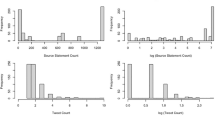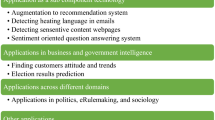Abstract
Identification of the influential users is one of the most practical analyses in social networks. The importance of this analysis stems from the fact that such users can affect their followers “/friends” viewpoints. This study aims at introducing two new indices to identify the most influential users in the Twitter social network. Four sets of features extracted from user activities, user profile, tweets, and actions performed on tweets are deployed to create the proposed indices. The available methods of detecting the most influential Twitterers either consider a limited set of features or do not accurately measure the effect of each feature. The indices proposed in this paper consider a comprehensive set of features and also provide a time-sensitive rank which can be used to measure the dynamic nature of influence. Moreover, the relative impact of each feature is computed and considered in the indices. We employ the indices to discover the influential Twitter users posting on Paris attacks in 2015, in a comprehensive analysis. The influence trend of users’ tweets in a 21-day period discloses that 76% of the users do not succeed in posting a second influential tweet. Results reveal that the proposed indices can detect both the publicly recognized sources (like celebrities) and also the less known individuals which gain credit by posting several influential tweets after a specific event. We further compare the proposed indices with other available approaches.










Similar content being viewed by others
Notes
https://about.twitter.com/company [January 20, 2018].
https://2015.twitter.com/most-influential [January 20, 2018].
Technique for order performance by similarity to ideal solution.
https://developers.google.com/maps/documentation/geocoding/intro [January 20, 2018].
References
Boyd D, Ellison NB (2008) Social network sites: definition, history, and scholarship. J Comput Commun 13:210–230. https://doi.org/10.1111/j.1083-6101.2007.00393.x
Sathik MM, Rasheed AA (2011) Social network analysis in an online blogosphere. Int J Eng Sci Technol 3:117–121
Lahuerta-Otero E, Cordero-Gutiérrez R (2016) Looking for the perfect tweet. The use of data mining techniques to find influencers on Twitter. Comput Human Behav 64:575–583. https://doi.org/10.1016/j.chb.2016.07.035
Himelboim I, Smith MA, Rainie L et al (2017) Classifying Twitter topic-networks using social network analysis. Soc Media + Soc. https://doi.org/10.1177/2056305117691545
Nakov P, Ritter A, Rosenthal S et al (2016) SemEval-2016 Task 4: sentiment analysis in Twitter. In: Proceedings of the 10th international workshop on semantic evaluation
Overbey LA, Paribello C, Jackson T (2013) Identifying influential Twitter users in the 2011 Egyptian revolution. In: Social computing, behavioral-cultural modeling, and prediction lecture notes computer science, vol 7812, pp 377–385. https://doi.org/10.1007/978-3-642-37210-0_41
Kumar S, Fred, Zafarani R, Liu H (2013) Whom should i follow? Identifying relevant users during crises. In: Proceeding HT’13 proceedings of the 24th ACM conference on hypertext and social media, pp 139–147. https://doi.org/10.1145/2481492.2481507
Xu B, Huang Y, Kwak H, Contractor NS (2013) Structures of broken ties: exploring unfollow behavior on Twitter. In: Ideology, politics, and social curation: Recent work Twitter, pp 871–876. https://doi.org/10.1145/2441776.2441875
Bollen J, Mao H, Zeng X (2011) Twitter mood predicts the stock market. J Comput Sci 2:1–8. https://doi.org/10.1016/j.jocs.2010.12.007
Zhang M, Guo L, Hu M, Liu W (2017) Influence of customer engagement with company social networks on stickiness: mediating effect of customer value creation. Int J Inf Manag 37:229–240. https://doi.org/10.1016/j.ijinfomgt.2016.04.010
Jones JJ, Bond RM, Bakshy E et al (2017) Social influence and political mobilization: further evidence from a randomized experiment in the 2012 US presidential election. PLoS ONE 12:1–9. https://doi.org/10.1371/journal.pone.0173851
Francalanci C, Hussain A, Merlo F (2015) Representing social influencers and influence using power-law graphs. Appl Math Inf Sci 9:2453–2465. https://doi.org/10.12785/amis/090529
Francalanci C, Hussain A (2016) Discovering social influencers with network visualization: evidence from the tourism domain. Inf Technol Tour 16:103–125. https://doi.org/10.1007/s40558-015-0030-3
Francalanci C, Hussain A (2016) Influence-based Twitter browsing with NavigTweet. Inf Syst 64:119–131. https://doi.org/10.1016/j.is.2016.07.012
Servi L, Elson SB (2014) A mathematical approach to gauging influence by identifying shifts in the emotions of social media users. IEEE Trans Comput Soc Syst 1:180–190. https://doi.org/10.1109/TCSS.2014.2384216
Cha M, Haddadi H, Benevenuto F, Gummadi KP (2010) Measuring user influence in Twitter: the million follower fallacy. In: ICWSM’10: Proceedings of international AAAI conference on Weblogs and social, pp 10–17
Metra I (2014) Influence based exploration of Twitter social network. Polytechnic University of Milan, Milan
Asadi M, Agah A (2018) Characterizing user influence within Twitter. In: Advances on P2P, parallel, grid, cloud and internet computing, pp 122–132
Saaty TL (1980) Decision making for leaders: the analytical hierarchy process for decisions in a complex world. McGraw-Hill, New York
Saaty TL (2001) The analytic hierarchy process: planning, priority setting, resource allocation. RWS Publications, Pittsburgh
Freeman LC (1979) Centrality in social networks conceptual clarification. Soc Netw 1:215–239. https://doi.org/10.1016/0378-8733(78)90021-7
Claros I, Cobos R, Collazos CA (2016) An approach based on social network analysis applied to a collaborative learning experience. IEEE Trans Learn Technol 9:190–195. https://doi.org/10.1109/TLT.2015.2453979
Sabidussi G (1966) The centrality index of a graph. Psychometrika 31:581–603. https://doi.org/10.1007/BF02289527
Liu J, Xiong Q, Shi W et al (2016) Evaluating the importance of nodes in complex networks. Phys A Stat Mech Appl 452:209–219. https://doi.org/10.1016/j.physa.2016.02.049
Hosseini-Pozveh M, Zamanifar K, Naghsh-Nilchi AR (2017) A community-based approach to identify the most influential nodes in social networks. J Inf Sci 43:204–220. https://doi.org/10.1177/0165551515621005
Bonacich P (1972) Factoring and weighting approaches to status scores and clique identification. J Math Sociol 2:113–120. https://doi.org/10.1080/0022250X.1972.9989806
Brin S, Page L (1998) The anatomy of a large scale hypertextual Web search engine. Comput Netw ISDN Syst 30:107–117. https://doi.org/10.1016/S0169-7552(98)00110-X
Kleinberg JONM (1999) Authoritative sources in a hyperlinked. Environment 46:604–632
Du Y, Gao C, Hu Y et al (2014) A new method of identifying influential nodes in complex networks based on TOPSIS. Phys A Stat Mech Appl 399:57–69. https://doi.org/10.1016/j.physa.2013.12.031
Bian T, Hu J, Deng Y (2017) Identifying influential nodes in complex networks based on AHP. Phys A Stat Mech Appl 479:422–436. https://doi.org/10.1016/j.physa.2017.02.085
Leung CK-S, Tanbeer SK, Cameron JJ (2014) Interactive discovery of influential friends from social networks. Soc Netw Anal Min 4:154. https://doi.org/10.1007/s13278-014-0154-z
Peng S, Yang A, Cao L et al (2017) Social influence modeling using information theory in mobile social networks. Inf Sci (NY) 379:146–159. https://doi.org/10.1016/j.ins.2016.08.023
Zengin Alp Z, Gündüz Öğüdücü Ş (2018) Identifying topical influencers on Twitter based on user behavior and network topology. Knowl-Based Syst 141:211–221. https://doi.org/10.1016/j.knosys.2017.11.021
Bonacich P, Lloyd P (2001) Eigenvector-like measures of centrality for asymmetric relations. Soc Netw 23:191–201. https://doi.org/10.1016/S0378-8733(01)00038-7
Akritidis L, Katsaros D, Bozanis P (2011) Identifying the productive and influential bloggers in a community. IEEE Trans Syst Man Cybern Part C Appl Rev 41:759–764
Inman J (1835) Navigation and nautical astronomy: for the use of British Seamen. Kessinger Publishing, London
Chartrand G (1984) Introductory graph theory. Dover Publications, New York
Myers SA, Sharma A, Gupta P, Lin J (2014) Information network or social network? The structure of the Twitter follow graph. In: Proceeding WWW’14 companion proceedings of the 23rd international conference on World Wide Web. Seoul, Korea, pp 493–498
Grandjean M (2016) A social network analysis of Twitter: mapping the digital humanities community. Cogent Arts Humanit 3:1–14. https://doi.org/10.1080/23311983.2016.1171458
Agarwal N, Liu H, Tang L, Yu PS (2008) Identifying the influential bloggers in a community. In: Proceedings of the international conference Web search web data mining—WSDM’08, pp 207–218. https://doi.org/10.1145/1341531.1341559
Chu Z, Gianvecchio S, Wang H, Jajodia S (2012) Detecting automation of Twitter accounts: are you a human, bot, or cyborg? IEEE Trans Dependable Secur Comput 9:811–824. https://doi.org/10.1109/TDSC.2012.75
Stefanowski J, Weiss D (2003) Carrot 2 and language properties in web search results clustering. In: Lecture notes in artificial intelligence advanced web intelligence proceedings of the first international Atlantic Web intelligence conference, vol 1, pp 1–10. https://doi.org/10.1007/3-540-44831-4_25
Vaidya OS, Kumar S (2006) Analytic hierarchy process: an overview of applications. Eur J Oper Res 169:1–29. https://doi.org/10.1016/j.ejor.2004.04.028
Choudhary P (2016) Ranking Terrorist Nodes of 26/11 Mumbai Attack using analytical hierarchy process with social network analysis. In: 11th annual symposium on information assurance (ASIA’16)
Liebowitz J (2005) Linking social network analysis with the analytic hierarchy process for knowledge mapping in organizations. J Knowl Manag 9:76–86. https://doi.org/10.1108/13673270510582974
Moh TS, Shola SP (2013) New factors for identifying influential bloggers. In: Proceedings—2013 IEEE international conference on big data, Big Data 2013, pp 18–27
Author information
Authors and Affiliations
Corresponding author
Additional information
Publisher's Note
Springer Nature remains neutral with regard to jurisdictional claims in published maps and institutional affiliations.
Rights and permissions
About this article
Cite this article
Rezaie, B., Zahedi, M. & Mashayekhi, H. Measuring time-sensitive user influence in Twitter. Knowl Inf Syst 62, 3481–3508 (2020). https://doi.org/10.1007/s10115-020-01459-y
Received:
Revised:
Accepted:
Published:
Issue Date:
DOI: https://doi.org/10.1007/s10115-020-01459-y




